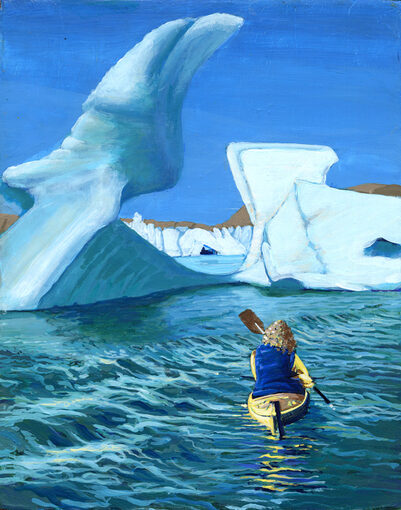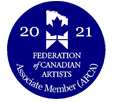
2009 - 2012’sWhat if
I painted 178 canvases that looked about to burst their britches?
A turning point in my paintings came in 2009. I had an opportunity to have my work critiqued by Robert Genn and Janice Robinson, signature members of the Federation of Canadian Artists. Arriving with a portfolio, a brochure, a CD, and several favourite large canvases, I felt comfortable with the coming review.
After introductions, Robert asked why I was there. I replied that I wanted to know where I was on the road to success in the art world?
He looked over his glasses at me and said, “You are on page three of a 783-page book. Stop creating those large paintings nobody can afford. Go to your room and paint 300-11 x 14-inch canvases. When you have finished, you will have a style people will recognize.”
I left the critique feeling like the Black Knight guarding the bridge in Monty Python’s Holy Grail. The following week, I started a twelve-by-four-foot structured painting that became the feature in the Ferry Building Gallery as part of West Vancouver’s Harmony Arts Festival. I also started my first “small” piece.
I finished 178 paintings over the next few years and Robert was absolutely correct. In fact, on April 12, 2012, after 151 paintings, he released me from my small painting penury with half time off for good behavior.
The following winter, he gave one of his lectures to my Arts Connection group. I met him at the door and gave him a work I had done of him painting plein air on the beach. I said it was #36 of the series. He could throw it in the trash or hang it in his garage, I didn’t care.
He looked at it for a few moments and said “I’m going to have it framed and give it to my wife.”
I went from page three to having one of my paintings hanging in his house.
With Robert’s passing, the Genn family continued publish a weekly email letter to 180,000 artists and art lovers around the globe. This is his reply to my letter:
April 13, 2012
Rebellious student
Yesterday, Richard Alm of Vancouver, B.C. wrote,
“I recently completed 151 of the 300-11 x 14’s you requested as part of the ‘Genn School of Go-To-Your-Room.’ I’m getting very itchy to do some larger ones. Do you permit making larger ones from the better of the smaller ones before the 300 have been completed?”
Thanks, Richard. When we last had spoken, I also suggested you follow your nose and don’t pay too much attention to any instructor, including me. I thought I also implied that those small paintings might be done concomitantly with any other work you might have in mind. If I missed this point, I apologize.
As an artist I believe in free will—but I also believe in preparatory exercises. Whether it be a series of exploratory roughs, comps, a-painting-a- day, or thumbnails before a more ambitious project, sketches pave the way to professionalism. Here’s a reminder of what sketches can do for you:
Make your mistakes smaller, not larger. By including “notan” sketches (simple black and white patterns), you learn to find better compositions, discover the best angles, aspects and forms of a subject. Learn to work fresher and looser so you’ll have less investment & obligation. Ask yourself, “What could be?” and have more fun wherever you go. Make more sense of your visual world and its manifestation in your art.
Preparatory sketches help you understand what you are trying to do while helping you to feel less precious about your work. Small works tend to be automatically stronger. For one thing, they seem to more easily take up the whole picture plane. Further, you need not make your smaller works too comprehensive (This may be a problem with your sketches, Richard—they look like they’re trying to burst their britches and become larger paintings).
Being a basically contrary person myself, I find it useful to ask, “What do I want to do today?” A sketch in the cold grey light of dawn often takes just a few minutes to find the way. Big, small, difficult, easy— the day’s karma appears like a genie. Then there’s nothing to it but to do it.
Best regards,
Robert
PS: “Forewarned, forearmed; to be prepared is half the victory.” (Miguel de Cervantes) “Failure to prepare is preparing to fail.”



















































